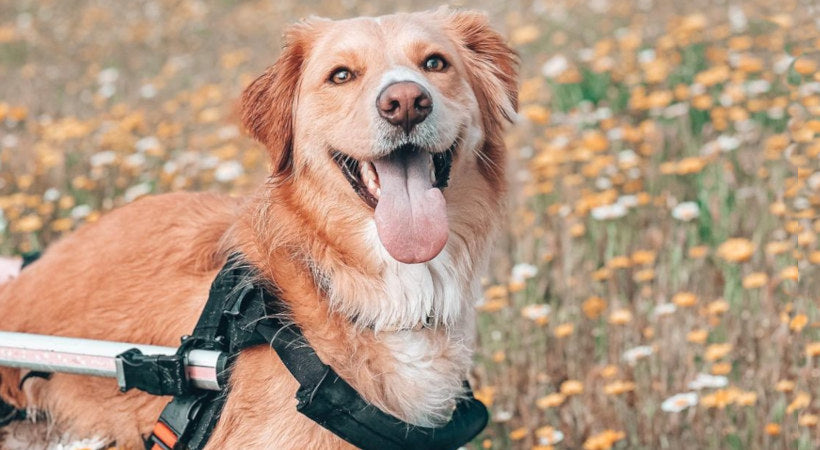Sit Down Dog Wheelchairs

Are Paralyzed Dogs Happy? How to Improve a Paralyzed Pet’s Quality of Life
A paralyzed dog can live a long, comfortable, and happy life. Caring for a paralyzed pet can mean a little extra work for their family, but it’s worth it! With your love and support most handicapped dogs can live a happy, healthy, and active life.
Here’s how you can make sure your paralyzed dog is happy:
Understand the Care Your Paralyzed Dog Needs
Caring for a special needs dog takes patience, support from friends and family, and a guiding hand from your pet professional. It takes time to learn everything you need to know about caring for your paralyzed dog, but here are a few ways you can make sure dog gets the care it needs:
Paralyzed Dog Hygiene and Grooming Needs

Your dog’s grooming needs are different than they were before. An active dog will naturally wear down their toenails as they walk around. A paralyzed dog won’t wear down their toenails as often so they will need their nails trimmed more often. Excess hair between their paw pads can make it harder for your dog to find their traction on slippery surfaces. Keeping this hair trimmed can make it easier for your dog to move inside their home.
Incontinent pets who wear diapers will need them changed regularly. Wearing a dirty diaper for too long can lead to urine burns and infection on a dog’s sensitive skin. Changing a dog's diaper regularly can prevent UTIs and other infections. Likewise, soiled bedding or blankets will need to be swapped out and cleaned regularly.
Expressing a Dog's Bladder
Most paralyzed pets are also incontinent, meaning they are unable to control their bladder or bowel movements. Since they are unable to empty their bladder naturally, many handicapped dogs need their owners to help them manually express their bladder.
Expressing a dog’s bladder is necessary to promote a healthy bladder and avoid infection. Most paralyzed dogs will need their bladder expressed manually four times a day until they can pee on their own.
Prevent Pressure Sores
Whether your dog is dealing with recent paralysis or long term mobility problems, keeping them safe is vitally important. A paralyzed dog spends a lot of time “down”, since they may be unable to reposition themselves when they need to, your dog will need you to reposition them.
Pressure sores and ulcers can form when a dog rests for too long in one spot, especially on bony parts of their body like their hip joint. Repositioning them every few hours and cushioning them with a hip donut or padding can help prevent bed sores from forming. Pressure sores and ulcers are difficult to treat, preventing them in the first place is the best way to keep your down dog healthy.
Avoid Slip and Fall Accidents
Make sure your dog has easy access to both their food and water bowls. This helps your dog avoid slip and fall accidents on long walks across slippery floors. Moving their bowls closer also ensures that they are able to easily hydrate and feed themselves.

Get a Dog Wheelchair
An active dog is a happy dog. Getting your dog their first set of wheels will change their life and yours. When a dog becomes paralyzed, they often become depressed and frustrated.
A dog wheelchair gives paralyzed pets back their freedom and makes it easier for a dog to walk again. With the support of a dog mobility cart, your dog regains the ability to run, play with their family, and enjoy their life.
Dog wheelchair benefits:
- Give your dog their independence
- Allow your dog to pee or poop while standing
- Make it easier for your dog to go on their daily walk
- Provide support during rehabilitative exercise
- Give dog the support they need to stand up and walk on their own
- Help injured pets regain strength and minimize loss of muscle
Choosing an adjustable dog wheelchair, like the Walkin’ Wheels dog wheelchair, gives you the ability to add a front wheel attachment at any time. This allows you to easily convert your rear wheelchair into a full support wheelchair if your dog’s front legs weaken. Keeping your paralyzed dog active can extend their life and slow down the progression of their mobility loss.









